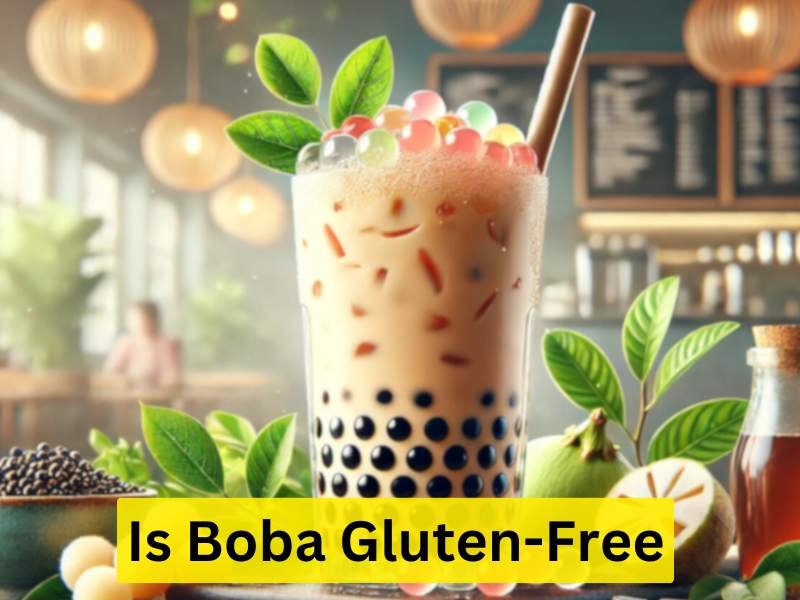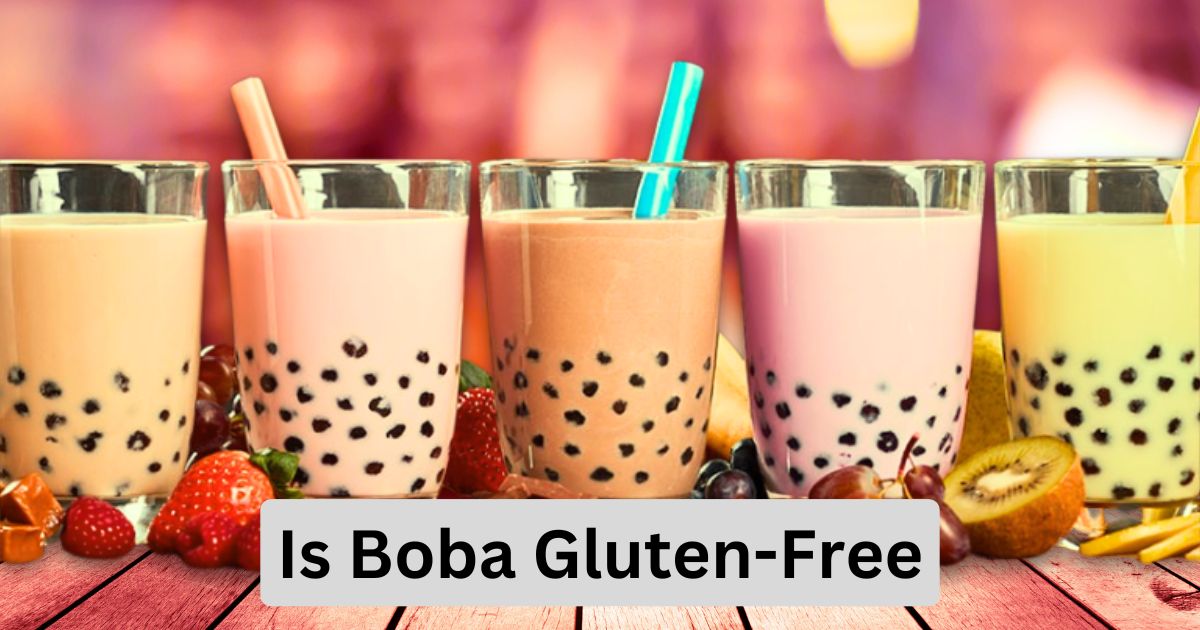What Is Boba Tea, and Why Is It So Popular?
Boba tea, also known as bubble tea, is a sweet and refreshing beverage that originated in Taiwan in the 1980s. It’s a unique combination of tea, milk (optional), sweeteners, and chewy tapioca pearls, also called “boba.” These pearls are made from tapioca starch, giving them their iconic chewy texture. In addition to tapioca pearls, some variations include jelly, popping boba, or fruit-based toppings.
Boba tea gained international popularity for its unique taste, wide variety of flavors, and fun, interactive experience. Flavors range from classic milk tea and matcha to fruit-based teas like passionfruit and mango. For people transitioning to a gluten-free lifestyle, understanding questions like “Is Boba Gluten-Free?” is essential, as highlighted in the ultimate guide to gluten-free living.
The drink’s vibrant colors and customizable options make it a favorite for social media posts. Many people who enjoy boba are also mindful of dietary concerns, such as those covered in celiac disease basics, to ensure their choices align with their health needs.
Understanding Gluten: What It Is and Why It Matters
Gluten is a protein found in wheat, barley, rye, and their derivatives. It’s responsible for giving baked goods their elasticity and chewy texture. While gluten is safe for most people, it can be harmful to those with gluten-related disorders such as celiac disease, gluten intolerance, or wheat allergy. If you’re unsure about your symptoms, understanding gluten inflammation can offer insight into its effects on the body.
For people with celiac disease, even a small amount of gluten can trigger an immune response, leading to intestinal damage and other health issues. This is why it’s crucial to identify gluten-free options when exploring popular foods and beverages.
Is Boba Gluten-Free? A Detailed Answer

The big question is, “Is boba gluten-free?” The short answer is yes, boba itself is generally gluten-free because it is primarily made from tapioca starch, which is derived from the cassava plant—a naturally gluten-free ingredient. However, the safety of boba for someone with celiac disease or gluten sensitivity depends on how it’s prepared and what additional ingredients are used.
While traditional tapioca pearls are gluten-free, flavored or colored pearls may sometimes contain additives or cross-contamination with gluten during processing. To ensure your boba is safe, look for products explicitly labeled as gluten-free. For example, checking food labels for potential allergens, as detailed in the ultimate guide to gluten-free crackers, can help make informed decisions.
Additionally, it’s worth being cautious about the tea bases, syrups, and toppings added to your drink. Some sweeteners or sauces may contain gluten, so it’s vital to ask for detailed ingredient information when ordering your boba tea.
Ingredients in Boba: What You Need to Know About Gluten
The primary ingredient in traditional boba pearls—tapioca starch—is naturally gluten-free. Tapioca starch is extracted from cassava roots and doesn’t involve any wheat, barley, or rye derivatives. This makes it an excellent base for gluten-sensitive individuals. However, other ingredients used in boba tea may pose a risk.
Here are some key ingredients to watch for:
- Tea bases: Most teas, such as black or green tea, are naturally gluten-free. Be cautious if pre-mixed powders are used, as they may contain gluten-based thickeners or flavorings.
- Sweeteners and syrups: Simple syrups are typically gluten-free, but flavored syrups might have additives or gluten traces. Understanding hidden sources of gluten is critical when making choices.
- Toppings: Some toppings like fruit jellies, popping boba, or custards may use gluten-containing stabilizers. Always double-check when experimenting with toppings.
To make your boba tea completely gluten-free, consider customizing your drink by choosing plain tapioca pearls and requesting a simple, unflavored tea base.
How to Choose Gluten-Free Boba Options
Choosing gluten-free boba options doesn’t have to be complicated. Start by selecting reputable cafes or brands that cater to dietary restrictions. Many shops now understand the demand for allergen-free food and drinks, including gluten-free boba.
When ordering, communicate your dietary needs clearly. Ask the staff if the tapioca pearls, tea bases, and syrups are gluten-free. If you’re concerned about cross-contamination, consider exploring at-home options. Making your own boba tea allows you to control the ingredients and avoid potential allergens. A simple recipe using gluten-free tapioca pearls, as mentioned in gluten-free flour alternatives, can help you enjoy your favorite drink without worry.
For pre-packaged options, check the labels carefully. Brands that prioritize gluten-free products often have certifications to indicate they are safe for consumption. Researching celiac disease symptoms in females and other related issues may also guide you to make informed choices about your food and beverage intake.
Common Gluten Sources in Boba Tea
Although boba tea is generally considered gluten-free, there are a few potential sources of gluten to be aware of when ordering or making your drink:
- Flavored Tapioca Pearls: Some boba pearls contain flavoring agents or food coloring that might use gluten-based stabilizers.
- Pre-Mixed Powders: Milk tea powders, especially those for matcha or taro, may contain gluten as a thickener or filler.
- Toppings: Items like pudding, custard, and flavored jellies could include gluten-containing ingredients, such as malt extract.
- Tea Syrups: Some syrups used in bubble tea contain hidden gluten due to additives. Understanding gluten-loading for celiac tests can help identify problematic ingredients.
To avoid these risks, choose simple, naturally gluten-free ingredients or verify with the staff if their products are safe for gluten-sensitive individuals.
Hidden Gluten Risks in Boba Tea Toppings
One of the biggest risks for gluten in boba tea comes from the variety of toppings offered. While traditional tapioca pearls are gluten-free, many popular toppings might not be:
- Custard and Pudding: Often thickened with wheat-based starch or other gluten-containing agents.
- Flavored Jellies: Some fruit-flavored jellies use gluten-based stabilizers to maintain their texture.
- Popping Boba: These bursting balls filled with juice may have gluten if artificial flavorings or stabilizers are used.
Understanding hidden symptoms of celiac disease can help you recognize issues early if you accidentally consume gluten. Always ask for allergen information before choosing these toppings to ensure they’re gluten-free.
Cross-Contamination: How It Affects Gluten-Free Boba Tea
Even when the ingredients in boba tea are naturally gluten-free, cross-contamination can occur during preparation. This is especially common in shared kitchens where utensils, blenders, or tea-making equipment may come into contact with gluten-containing products.
To minimize the risk of cross-contamination:
- Ask about preparation methods: Ensure the cafe follows safe practices for handling gluten-free items.
- Visit dedicated gluten-free shops: Some boba cafes specialize in allergen-free foods and beverages.
- Make it at home: Preparing boba tea at home allows you to control the environment and avoid contamination risks.
Tips for Ordering Gluten-Free Boba Tea Safely
Ordering gluten-free boba tea safely requires clear communication and knowledge of your options. Here are some tips to help:
- Ask Questions: Always ask about the ingredients in tapioca pearls, tea bases, and toppings.
- Stick to Simple Options: Choose plain teas, such as black or green tea, without added flavors.
- Verify Certifications: Look for products labeled gluten-free or certified by trusted organizations.
- Choose Trusted Brands: Research cafes or brands that are known for accommodating dietary restrictions.
Additionally, resources like the celiac disease guide can help you better understand how to navigate dining out safely.
FAQs About Gluten-Free Boba Tea
- Is boba tea always gluten-free?
No, while traditional tapioca pearls are gluten-free, some toppings, syrups, or additives may contain gluten. Always check the ingredients. - Can I make gluten-free boba tea at home?
Yes! Using certified gluten-free tapioca pearls and simple syrups ensures your homemade boba is safe. - What are some gluten-free boba brands?
Brands like Tea Zone and WuFuYuan offer gluten-free tapioca pearls. Check labels before purchasing. - What toppings are safe for gluten-sensitive individuals?
Plain tapioca pearls and fresh fruit toppings are typically gluten-free. Be cautious with custards and flavored jellies. - Does cross-contamination pose a risk in boba tea shops?
Yes, shared equipment in cafes can lead to cross-contamination. Always verify preparation methods. - Can boba tea syrups contain gluten?
Some flavored syrups may have gluten-based additives. Opt for simple sugar syrups to be safe.
Conclusion
Boba tea can be a delicious treat for those on a gluten-free diet, but it’s essential to be mindful of potential risks like additives, toppings, and cross-contamination. By asking the right questions, choosing trusted brands, and exploring at-home options, you can enjoy boba safely while adhering to your dietary needs. With proper research and preparation, you can indulge in this popular drink worry-free.

Hi, I’m Philip John – a writer at Celiac Magazine with a passion for uncovering the truth behind what we eat and how it affects our health. I dive deep into food science, nutrition, and living well with celiac disease, all with one goal: to make complex topics easy to understand and actionable. Whether you’re newly diagnosed or just curious about gluten-free living, I’m here to help you navigate it all with clarity and confidence.

